
The Czech Army procured their first major batch of military Land Rovers, primarily for formations earmarked for international deployment, at the end of the last millennium, writes Bob Morrison.
~
The civil wars in the former Socialist Federal Republic of Yugoslavia, which dragged out for a decade from 1991, were a tragedy for the people but one bright spark of hope was born out of the embers in the form of much closer international cooperation on peace and security in Europe.
In the aftermath of the demise of the Warsaw Pact and the break-up of the Soviet Union at the turn of the 1990s, many nations the east of the former Iron Curtain were now free to explore the possibilities of joining the European Community and NATO. These initial faltering steps lead to the formation in 1994 of an organisation called Partnership for Peace (PfP), which allowed troops from the Warsaw Pact states, plus formerly neutral countries such as Austria, Finland and Sweden, to train together for international peacekeeping duties alongside soldiers from the NATO nations. In the early days of PfP the gulf between the calibre of troops and the quality of equipment the various participants fielded, not to mention the differences in military doctrines, was so great that only the far-sighted could envisage such diverse military forces working in unison but the last two decades have seen a quantum leap forward by even the most junior of participants.
Today, as both Carl and myself have documented over the course of the last quarter century, there is virtually no difference between the standard of peacekeeping troops supplied by the old NATO core nations and the newer, former Warsaw Pact member, nations of which most are now fully integrated members of the Alliance. Additionally, as the newer nations have joined the NATO fold they have invariably modernised their equipment which, on the mechanised infantry side in particular, has in some areas put them in front of some NATO ‘old guard’ armies. However in this section of the website it is the Land Rover, rather than say the armoured personnel carrier, that we are most interested in so let’s look at Czech Defender models in service in 2002, before moving forward in time in the next two articles.
The images on this page were taken in Poland on the Crisis Reaction Operation (CRO) phase of Exercise STRONG RESOLVE 2002 (SR-02) which had a combined air, land and sea scenario. Around 16,000 military personnel from twenty-five PfP nations participated in the different scenarios which stretched from Arctic Norway, where NATO was fighting off an invading belligerent neighbour, across the Baltic Sea to western Poland, where fighting between ethnic groups from the mythical states of Woodland and Treeland had dragged the region into a civil war. On the ground in Poland, composite multinational military formations were tasked with sorting out the mess.
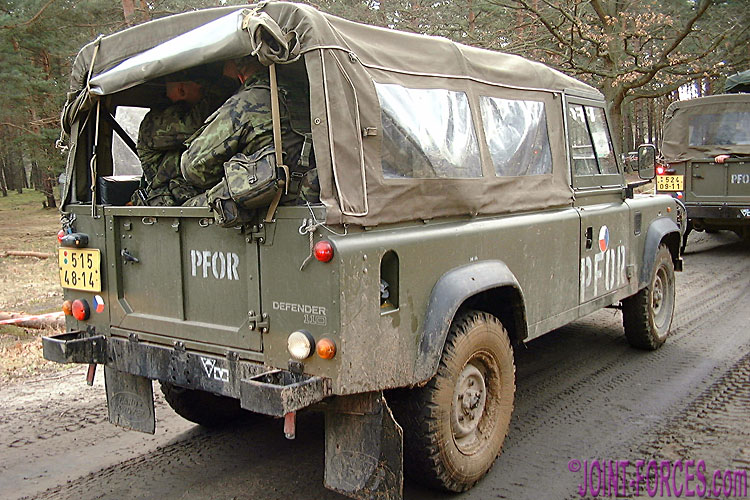
No British ground troops participated on the Polish CRO phase of SR-02 so I did not anticipate running across any military Land Rovers, but to my surprise towards the end of the exercise we came across these Defenders being used by a platoon of Czech peacekeepers operating as part of the Belgian Para contingent; it is not unusual on NATO multinational exercises for a battalion-size battlegroup to comprise companies contributed from different nations and for these companies to have a platoon from another nation under their command. Incidentally I said we, rather than I, as for this exercise I flew into Berlin and cadged a lift from Carl into Poland to both cut costs and have decent transport for the Polish exercise areas as at that time my colleague was the proud owner of a former BAOR One-Ten.
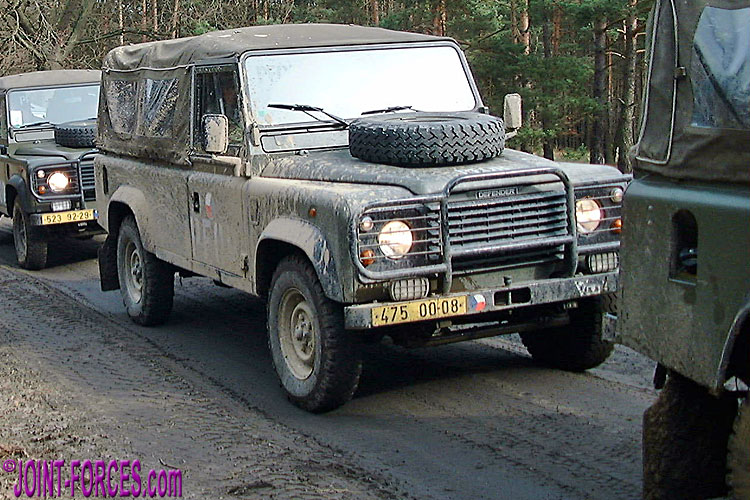
In 2002 I was told that the Czech Army procured its first major Land Rover batch specifically for peacekeeping use in Kosovo, where they were earmarked to serve under British command, though I have subsequently learned that only a comparatively small Czech contingent was actually deployed with KFOR. The four Defender 110 Tdi soft tops I snapped in Poland on SR-02 were finished in NATO IRR Green with two-piece side doors and were configured with inward facing rear bench seating for eight. The two main areas where they differed from their British Army pre-Wolf equivalents, other than having the later 300 Tdi turbo diesel engine rather than the naturally aspirated diesel, were the canopy sides and the rear tailgate. All but a very few British soft top Defenders have had plain canopy sides, whereas the Czech ones had two large rectangular window panels in each side which not only allowed the troops sitting in the rear to see out but also made the inside much lighter. The tailgate on these Czech Defenders was side-hinged, rather than the standard drop down item as fitted to British specification soft top military vehicles.
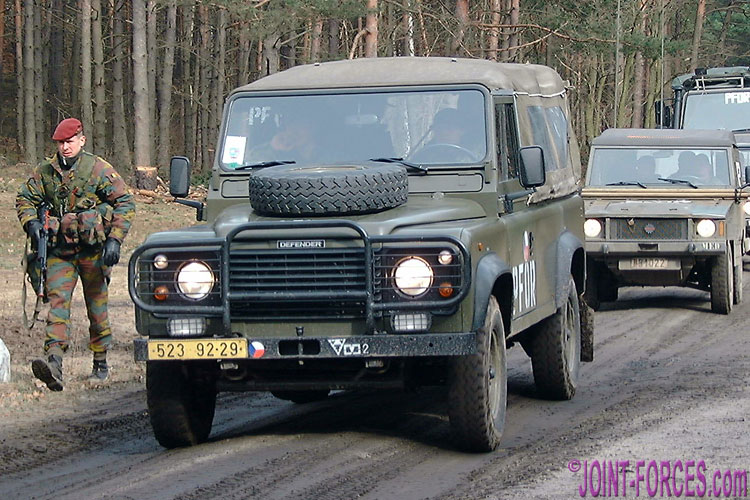
When I spotted these Defenders on the Wędrzyn Training Area, about 160km south of the Drawsko Pomorskie Training Area where the major part of the SR-02 CRO took place, we were moving between facilities laid on during a day trip for the media and regrettably I would not get another chance to photograph the Czech Paras or their Land Rovers. However while waiting for organised transport to another part of the range following a briefing, I spotted a Defender 90 Tdi Station Wagon which was being used as a staff vehicle by the Czechs. This Land Rover had military rear bumperettes like the Defenders in the Belgian convoy, and the same style of bull bar on the front, but its spare wheel was carried on the rear door, rather than the bonnet, and it was fitted with the fold-down side steps normally seen on Station Wagon models. Again, the paint finish was the standard NATO IRR Green; the white letter O stencilled on the doors showed that it was an Observer vehicle, rather than a PFOR (as in Peace FORce) role-player on the exercise.
On this exercise the Czech national flag and roundel insignia were affixed to the sides of all Land Rovers so that nobody could mistake who they were dealing with and the D-110 Rovers also sported small roundels near front and rear number plates, plus PFOR stencils on both sides. The tac-signs on front and rear bumper indicated that the peacekeepers using them were elite paratroopers from 2 Company of 43rd Airborne Battalion from the 4th Rapid Deployment Brigade.
[images © Bob Morrison]
- MLR 33 ~ Czech KAJMAN D130 RDV
- MLR 34 ~ Czech Army Defenders – Part 1
- MLR 35 ~ Czech Army Defenders – Part 2
- MLR 36 ~ Czech Army Defenders – Part 3
- MLR 37 ~ Armoured Czech Army Defenders


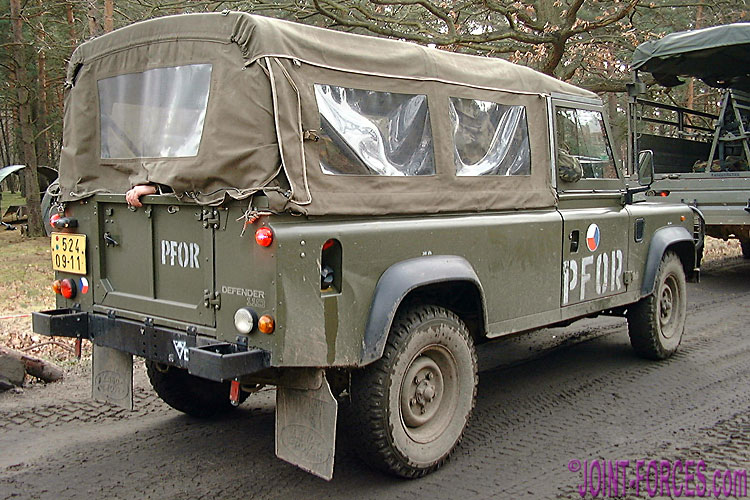
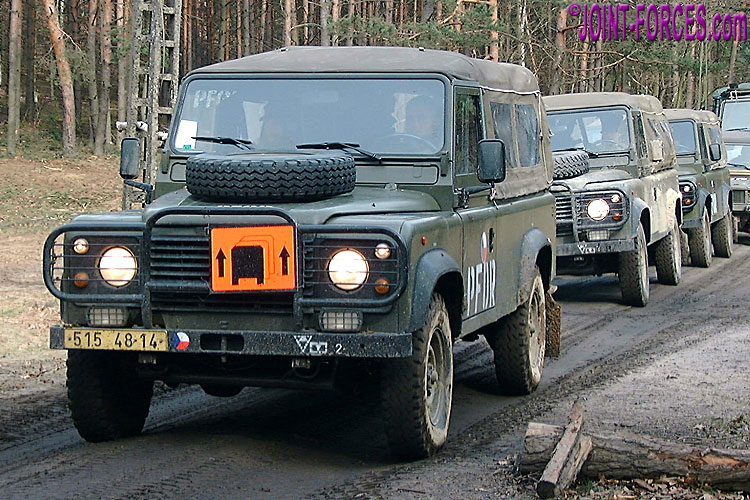
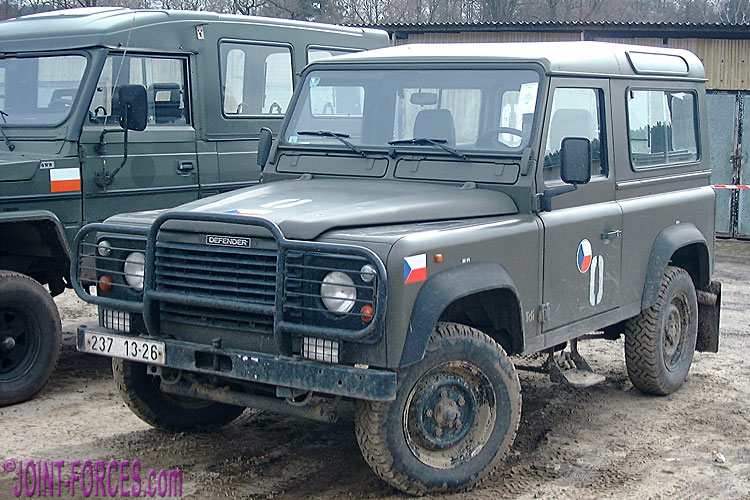
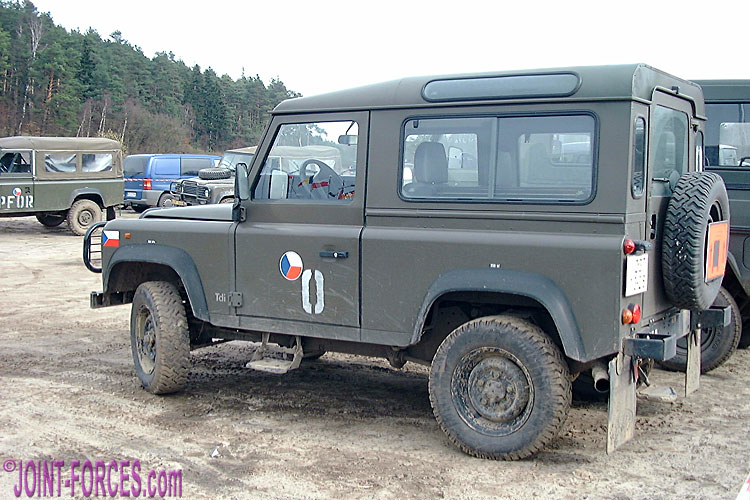


















Pingback : MLR 36 ~ Czech Army Defenders Part 3 - Joint Forces News
Pingback : MLR 33 ~ Czech KAJMAN D130 RDV - Joint Forces News
Pingback : MLR41 ~ Otokar Soft Top Defenders Pt1 - Joint Forces News
Pingback : Czech Army To Replace Land Rover Defender With Toyota Hilux - Joint Forces News
Pingback : MLR 33 ~ Czech KAJMAN D130 RDV | Joint Forces News
Pingback : MLR 54 ~ Slovak Armed Forces Defenders | Joint Forces News